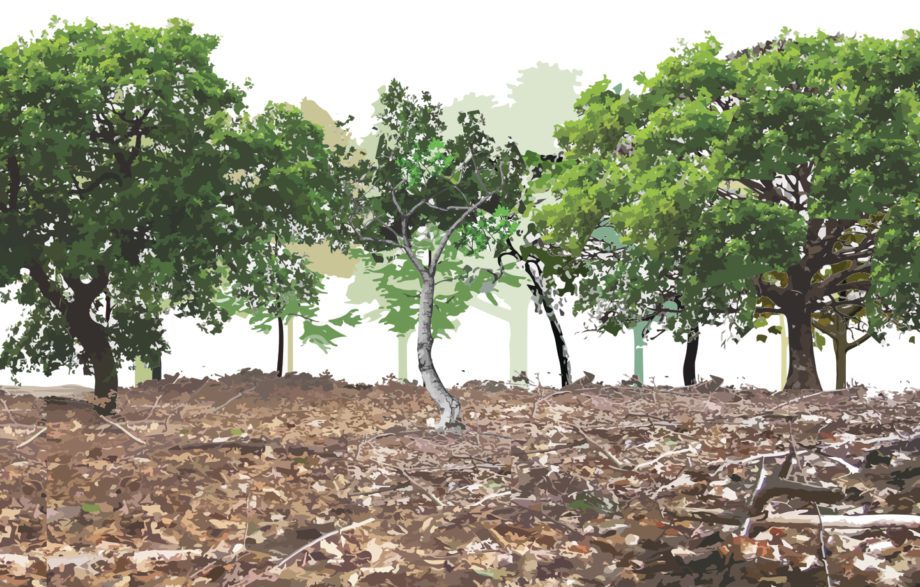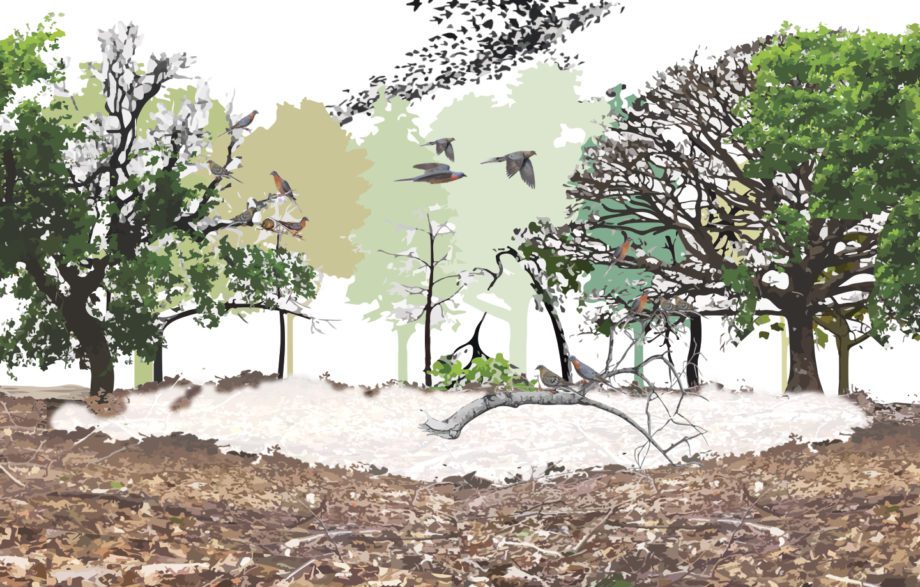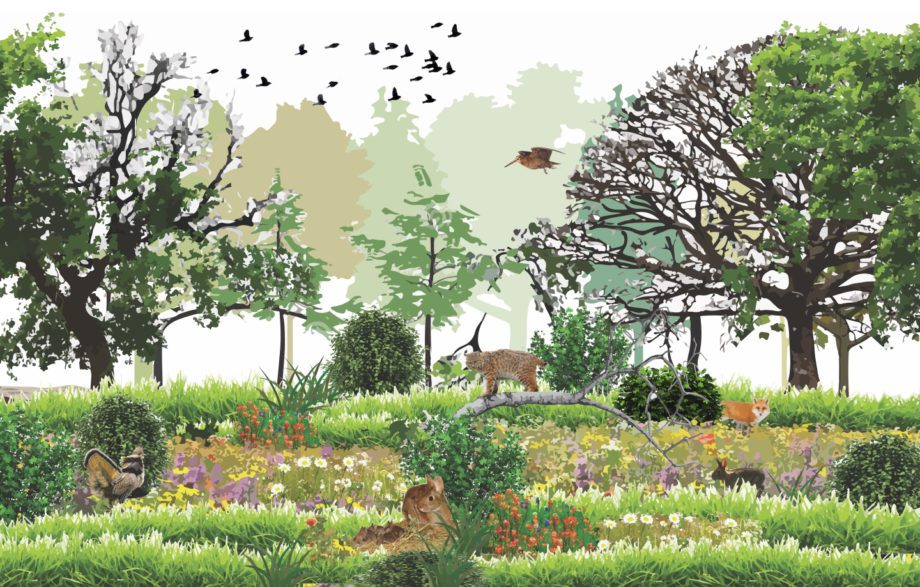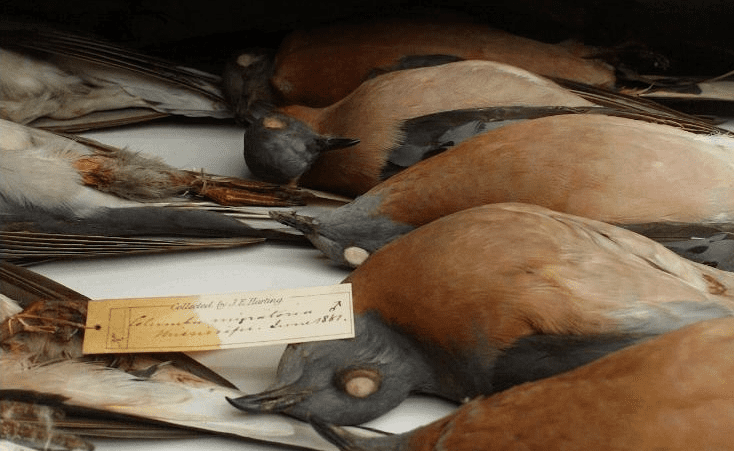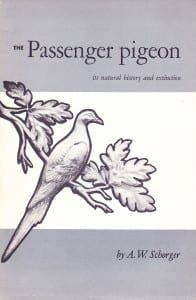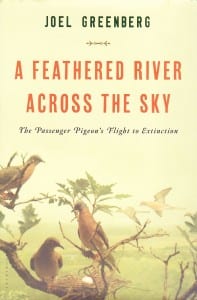The Passenger Pigeon was an ecosystem engineer of eastern North American forests for tens of thousands of years. Their large and dense flocks created forest disturbances and put regeneration cycles into motion. Huge, dense, nomadic flocks moved from one area to another constantly, shaping a mosaic forest landscape of successive patchwork habitats that supported rich and biodiverse ecosystems. Now, without the consistent disturbance regimes of natural fire cycles, weather events, and the Passenger Pigeon’s engineering role, these ecosystems are losing diversity.
The Passenger Pigeon lived in dense flocks because of a unique behavioral trait: their social breeding. Unlike Band-tailed Pigeons, which will nest in densities of one nest per three to four acres, Passenger Pigeons nested in densities of up to 100 nests per tree. When roosting, they were so hyper-social that the birds would line branches perched shoulder to shoulder and even sit on each other’s backs. There are historic accounts of roosting pigeons bending the crowns of young trees down to the forest floor under their combined weight.
The Passenger Pigeons’ hyper-sociality wasn’t only facilitated by behavioral traits; morphological and physiological traits were a key part of the birds’ adaptation to high social densities. Passenger Pigeon hatchlings grew up rapidly and were able to fly in 14 days, half the time required by Band-tailed Pigeons. This rapid growth meant that breeding Passenger Pigeons could leave nesting sites quickly before exhausting the local food supply.
Male and female Passenger Pigeons looked different, which is a rare trait among the world’s more than 350 species of pigeons and doves. The birds’ appearance may not seem important to the Passenger Pigeon’s ecological function, but a bird’s plumage is key to how mates are chosen in social flocks. The red breasts of males were likely a signal of superior fitness to females seeking the best mate in a crowd. The graduated tail of the Passenger Pigeon was likely also used in courtship displays and influenced mate choice. Tail shape also affects flight maneuverability, an important factor when flying only a few inches from dozens of other birds at speeds over 60 miles per hour.
A majority of the skepticism surrounding Passenger Pigeon de-extinction is based on popularized misconceptions about the species, misconceptions rooted in outdated research or untested hypotheses. New data has set the record straight about the natural history of this beneficial forest bird. Below you can find the facts regarding some of the leading misconceptions concerning Passenger Pigeons.
Misconception 1: Passenger Pigeons were not abundant before the arrival of Europeans to North America
This idea arose in the 1980’s to address the seeming lack of Passenger Pigeon bones in archaeological sites in the northeastern United States. The assumption was that if there were billions of Passenger Pigeons in the past there should be many bones. By comparison, Turkey and other bird remains were more numerous than pigeon bones in historic Amerindian village sites.
The hypothesis devised to answer this conundrum was that: 1) Native peoples competed with Pigeons for acorns and other nuts, keeping their numbers in check; 2) The genocide of Native people through warfare and disease after the arrival of Europeans to North America relieved competition for acorns, allowing the Passenger Pigeon population to boom.
The facts
Archaeological remains do not reflect population sizes accurately; the only thing they indicate reliably is the presence of a species during a given time period. In fact, using the same study technique, another analysis found that Passenger Pigeons were abundant in the Southeastern United States prior to European arrival.
Our current population genetics analyses show that the Passenger Pigeon was stably abundant for tens of thousands of years, before humans arrived in North America.
Misconception 2: The Passenger Pigeon required huge flocks to survive.
While contradictory to the first, both misconceptions are often cited in the scientific and popular literature. The idea is that Passenger Pigeons evolved to live in huge flocks and became dependent on their large flocks, meaning they could not produce enough offspring to survive unless there were billions of them, either for social reasons (they would not breed in small flocks), for predator reasons (they could not satiate predators without huge flocks), or for resource reasons (they could not find adequate food sources in small populations).
The facts
Passenger Pigeons were observed breeding in single pairs and flocks of dozens during the 1800’s. Some of the last Passenger Pigeons collected from the wild were juveniles, proving that when there were only a few hundred birds left in the world they still produced offspring. Our current analyses of the Passenger Pigeon’s breeding success in the final stages of its decline indicate that the species’ reproductive rate was not affected by low numbers and flock fragmentation. However, it is unknown whether or not the birds could have rebounded because the species never had the opportunity. Harvesting of Passenger Pigeons only intensified as the birds became more rare. The Passenger Pigeon’s genome may hold the answers to the true minimum population size necessary for a viable population.
Misconception 3: Passenger Pigeons were dependent on a diet of acorns.
The hypotheses proposed by previous studies (as recent as 2014) have often assumed that the main food source of the Passenger Pigeon were acorns, meaning that the species was dependent on the presence and abundance of oak trees.
The facts
While acorns are the most cited food source, Passenger Pigeons were observed eating over 42 genera of plant seeds and fruits, even occasionally consuming insects. The bird was a superb generalist. Because the species was abundant for thousands of years, we now know that the Passenger Pigeon was abundant during periods of history in which oak trees were scarce, which means that the birds could not be dependent on them as their main food source. Their generalist diet allowed them to thrive even when their environment changed.
Misconception 4: The Passenger Pigeon was naturally vulnerable to extinction.
This misconception has been used for over a century to absolve humanity from causing the extinction of the Passenger Pigeon and explain how billions of birds disappeared so quickly.
The facts
Through studying population genetics, we can evaluate historic accounts with a more accurate understanding of Passenger Pigeon ecology. Consilience of multiple lines of data show that that the Passenger Pigeon did not exhibit any of the traits commonly associated with vulnerability to extinction. The species had a generalist diet, nomadic flocking, and the ability to reproduce at low numbers – all traits that made the bird very resilient to environmental change. The Passenger Pigeon was a “super species.” Had humans not commercially harvested Passenger Pigeons at the same time they deforested America the Passenger Pigeon would certainly still be alive today.
PASSENGER PIGEON PROJECT
visit www.passengerpigeon.org for more information.
Further Reading
The Passenger Pigeon
A.W. Schorger, 1955
Schorger’s book is the seminal treatise of passenger pigeon natural history. Though dated, the majority of the content is still robust when viewed through more recent discoveries and research.
A Feathered River Across the Sky
Joel Greenberg, 2014
Greenberg, the leading living expert in passenger pigeon history, brings Schorger’s work up to date and enriches the lore of the passenger pigeon with the human stories that shaped the avian species’ fate.
The Passenger Pigeon
W. B. Mershon, 1907
For the avid history buff, this book comprises firsthand accounts of the passenger pigeon – many of which Schorger referenced in his work.


